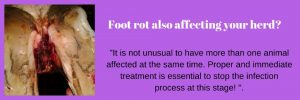The term foot rot or ‘hoof rot’ is one that might be used on your farm to describe a sore foot.

Before explaining the disorder itself, let’s first check whether Google can shed some light on the definition. Actually, none can be found when using ‘hoof rot’ to refer to cattle. Rather, it is commonly used to describe infection of the hoof in sheep, goats, and horses. Interestingly, the actual term used to describe ‘hoof rot’ in cattle is ‘foot rot’ or ‘foul-in-the-foot’.
To be clear, we will use ‘foot rot’ for this post, also referring to its scientific name, Interdigital necrobacillosis. However, we must be careful not to use this name to describe all lameness or different clinical pictures. This disorder is actually not a disease of the claw directly, but affects the subcutaneous tissue near the claw, particularly the tissues between the toes.
Much has been written about the disorder and my aim in this post is to briefly present the scientific facts and share with you my experience as a professional hoof trimmer.
What is the cause and what are the symptoms of foot rot?
Foot rot is a sudden and severe inflammation between the toes, most likely caused by the Fusobacterium necrophorum bacterium. This necro-bacillus (a germ that causes necrosis – meaning death of tissue) is always present in the environment.
It is commonly assumed that, under certain conditions, these bacteria are able to penetrate the skin between the toes, often through a small weakness or injury in the skin. The result is a reactive inflammation, often with a very rapid and severe onset. The swelling is centered above the claws and frequently on one foot only. It is not unusual to have more than one animal affected at the same time.
Proper and immediate treatment is essential to stop the infection process at this stage! Often a second stage develops in which also the interdigital space (the skin between the two claws) becomes inflamed with necrosis and pus. This causes a foul smell and results in a deep wound between the claws. As this deep type of wound heals, it will lead to excess growth, often referred to as a tyloma or corn.
A secondary symptom can be separation or detaching from the horn, like an ‘ingrown nail,’ at which point we enter another stage. This irritation will cause more swelling and inflammation and before you know it, the P3 bone or pedal joint will be irreversibly damaged.
All of the above might seem rather overwhelming, but as a positive point, I’d like to add that foot rot doesn’t need to be a serious dairy farm problem. Before going over the treatment procedures, the following question should be addressed.
How can foot rot be distinguished from other hoof disorders?
If your cow has been lame for a long period of time, the cause most likely is not foot rot. The foot may smell and look ‘rotten,’ but the inflammation is quite probably not caused by foot rot and we’re dealing with another cause of lameness. (If it was foot rot, this would be the point where it has gone into a secondary stage and now is affecting more areas of the foot or leg. In this case, we have a mess that is not easily reversed. I’ll get to that later in this article.)
Early recognition and action is the key for proper diagnosing. The other hoof diseases and their differentiating factors can be broken down as follows:
- A (complicated) sole ulcer, double sole, and white line defect are confusing and prone to be misdiagnosed under the name of ‘foot rot’. Holding on to the symptoms of foot rot: rapid onset (12-20 hrs), the ‘centered’ swelling above the foot, combined with a slight fever and an often noticeable production drop, will help you in your judgment.
- Heel erosion, where the heel bulb or ball horn is being undermined and deep grooves are appearing in the rear of the foot, can also cause some misdiagnosis. There is often a foul smell, but the onset of lameness occurs over an obviously much longer period and the lameness may not appear as severe. This defect affects the claws themselves, whereas foot rot appears ‘above’ the claws, within the foot.
- Hairy heel warts (Digital Dermatitis–DD) are also confused with foot rot, mainly because of the severity of lameness and the strong foul odor. Still, when compared to foot rot, this condition only affects the outer skin, primarily in the heel area. The ‘centered’ swelling might not be as obvious, but when you have a close look, you’ll find that the heel warts have an open ‘skin’ problem and a ‘ring’ of hairs on the outer circle. As a side note, I’d like to add that I’ve observed more than once that a hairy heel wart will cause the foot to be ‘weaker’ and less resistant, making it more prone to foot rot.
- Foreign objects can often cause major swelling in a short time. I’ve seen o-rings, baler twine, 5 inch nails, electrical staples, wraps that are overdue, etc. All of these will cause swelling, foul odor, and sometimes ‘self-amputation’ and are not classified under foot rot.
How to treat and take care of the animal when foot rot is diagnosed?
It is important to know our field of expertise. As hoof trimmers, we ought to take a step back here and refer you to your veterinarian to prescribe the proper treatment protocol to use on your farm. It is very important that you take quick action because of the deep tissues involved and the severity of this disease.
Some practical pointers that are worth sharing:
- If possible, separate the animal from the rest of the herd and give her soft bedding. This will help her to get around. With a sore foot, it is easier to stand on a straw pack than in a tight free stall on slippery floors.
- Give her easy access to feed. Often animals with foot rot have such a significant setback in the eating habits that she ends up with a displaced abdomen or even abortion.
- The later stage of foot rot can result in the loosening of the inner walls of the two claws. This results in an ‘in-grown nail’ effect and causes irritation. This irritating horn has to be removed with a sharp hoof knife and a local anesthetic is recommended.
- In my years of serving the dairy industry as a hoof trimmer, I have come across some great additions and alternatives to medications. One of my favorites is the ‘claw-bag’, which is applied to the affected foot for 30 minutes, twice a day, for 3-4 days. There are commercial bags available, but these are often too narrow when we have a severely swollen problem. For these cases, take a tire inner tube from a vehicle and cut a third out of it off to give it a ‘banana-shaped’ tube with two open ends. Next, you fold the ‘banana’ in half, bringing the open ends together. Take 3 ‘layers’ in one hand, 1 ‘layer’ in the other and you have a hoof bag. Making some holes on the top and stringing a rope through it will keep the bag in place. Add warm water to the bag, together with Epsom salts and Hoof Sol Liquid. Try it, you’ll love it.
- A great aid and safe alternative to antibiotics is the Hoof-fit Gel product, which contains chelated zinc, copper, and Aloe Vera. It should be used under a hoof wrap to help the healing process. For foot rot cases, it is recommended to remove the wrap no later than 1 day after application. The foot needs to ‘drain’ and you do not want to put a ‘plug’ on it.
- It is also very important to have regular checkups to ensure proper healing. Foot rot is usually under control in 3-4 days, but you should contact your veterinarian if problems persist. It is possible that you might have missed the correct diagnosis, but don’t worry – you’ll get better at it over time and it is sometimes hard to distinguish the differences in foot problems.
For foot rot cases, it is recommended to remove the wrap no later than 1 day after application.
What preventative steps can be taken to eliminate foot rot?
- Proper cleaning of the facilities is always a must, not only for hoof defects but also for other health issues. In particular, foot rot will not spread as rapidly between animals when the environment is clean. ‘Weakening’ factors, such as hairy heal warts (DD) and heel erosion, are also kept under better control in a clean barn.
- Timely control, treatment of an affected animal, and by removing her from the herd are great ways of preventing the spread of disease to her herd mates.
- Spread dry lime or other commercial drying powders around the water troughs as a preventive measure. This is not a proven method, but it has some merit due to the fact that it dries the feet and controls the bacteria count in the area.
- Clearing up ‘messy’ areas that have a lot of obstacles (rocks, nails, glass, and frozen dirt) is recommended to avoid injuries to the skin that can allow bacteria to enter the foot.
- Finally, the use of a foot bath as a preventive method is an option to control not only foot rot, but a lot of other hoof diseases. Unfortunately, copper sulfate and formalin are still used on a lot of dairies, but these products are not environment-friendly and cause pollution. Formalin is also known to be a cancer causing substance and should be avoided. Results accomplished with antibiotic containing foot baths are limited due to the fact that resistance builds up; therefore, there won’t be a response after prolonged use. More producers are turning to other, safe alternatives with greater success. For safe foot baths usage, preference is given to use a 5% Hoof Sol Bath solution which contains chelated copper and zinc. Check out the Intra Bath, which has a triple purpose construction: a dividing grill to eliminate some manure pollution, a smaller volume that allows 35% less product to be used, and the extra length to allow more ‘dips’ for each foot.
By: Koos Vis
Source: Diamond Hoof Care LTD




